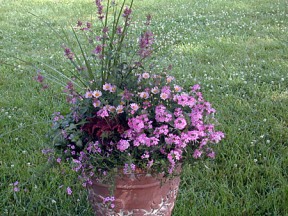
Container Gardens
Container gardens are nothing new to the home gardener- you may not have realised that you were making a container garden when you put that pot of geraniums by the front steps, but you were.
And now the industry has caught on to the possibility of selling ready-to-stick-out-
instant-container-gardens, and they are big business, one of the faster
growing segments of nursery products in many parts of the United States.
The best of the industry has always been willing to learn from the top amateur gardeners. Many people have a flair for putting together color combinations or playing one form or texture against the next, and the best designers have also worked out the ways of making their creations last in top display mode all season long.
There are many books with great examples for inspiration, usually with the principles that the designers have followed laid out very clearly. My friends at Branch-Smith Publishing, who are kind enough to let me pick up articles from their magazines, feature a website from Texas A. & M. University in the spring edition of the All-Industry Buyers Guide of GMPro, that deals with the details of design as well as having a database of relevant plant information, and a gallery of interesting examples..
http://aggie-horticulture.tamu.edu/floriculture
will take you to their home page with links to the database of plants
which they have tested, with details of plant care as well as photographs
of the plants.
|
You can also go directly to the plant container section, or get a similar education in basket plants, in each case with loads of illustrations. The text is a complete condensed course in the principles of design, defining each of the elements that make good design - focus, balance, form, texture, rhythm and proportion with illustrations of the applications of each. |
 |
As comprehensive as this is, there are links to three of the largest small-plant suppliers' sites, which each have their own full digest of the possibilities, including foolproof planting combinations for baskets and containers, designed to help their nursery customers put together planters that will give long service. A great example of marketing by the liner nurseries, that should not only help their nursery customers with their sales, but also put quality material into the hands of the consumer.
How much of this will the home gardener want to use? There is no reason not to dive into the whole course, including all of the material from the liner growers. Quite a task, mind, but you would certainly come out of the experience with a lot of insight into what makes a container successful. You would also be able to spot the nurseries who are customers of these "big three" small-plant producers. It is always fun to be a little more aware khan the salesperson thinks that you are.
The Texas site has some useful rules in their page called "tips." If I were asked to pull out a few nuggets for home gardeners from my own experience, they would be these:
Remember that you are creating a garden vulnerable to the elements. Water use will be high and soil heating may be extreme. Plan to water often and heavily, and set your soil mix to hold water, while not getting waterlogged.
Plant a combination of tallish, bushy and hanging. The pleasing composition of plant forms may be even more important than the flowers that they produce.
Use plenty of plants: thin later if you have to, but if you feed and water well, the plants will work in around oneanother.
Keep taking out and replacing as plants go past their best.
Plant for yourself, and for fun.
Back to Table of Contents
.